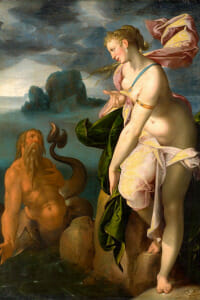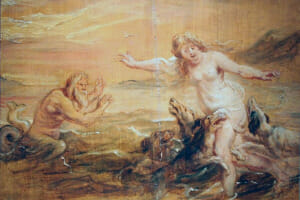Scylla in the Odyssey: The Monsterization of a Beautiful Nymph
 Scylla in the Odyssey is the female sea monster encountered by Odysseus and his men on their journey back home. She haunted the rocks on one side of the Strait of Messina, opposite another sea monster named Charybdis. The story of these creatures can be found in Book XII of Homer’s The Odyssey.
Scylla in the Odyssey is the female sea monster encountered by Odysseus and his men on their journey back home. She haunted the rocks on one side of the Strait of Messina, opposite another sea monster named Charybdis. The story of these creatures can be found in Book XII of Homer’s The Odyssey.
We have compiled all about her in this article, keep reading and you’ll find out so much.
Who Is Scylla in the Odyssey?
Scylla is one of the monsters that serve as an antagonist in the poem and gives Odysseus a hard time on his journey back home to Ithaca. She was a nymph that Poseidon fell in love with and turned into a monster with six heads.
Scylla Becoming a Monster
In Greek mythology, Scylla appears in Homer’s ancient Greek epic poem called The Odyssey. It is said that Scylla was once a beautiful nymph, and Glaucus, the sea god, fell in love with her. However, it was unrequited love, and Glaucus, being persistent with his love for her, asked the sorceress Circe to help him win her over through the use of drugs and incantations, which Circe was famous for. The sorceress eventually turned Scylla into a frightening monster because she was actually also in love with Glaucus.
In other accounts, Scylla becomes a monster because Poseidon, the sea god, was her lover. As a result, his jealous wife, Nereid Amphitrite, poisoned the spring water where Scylla bathed and turned her into a sea monster, but her upper body remained that of a woman. All of this information on how Scylla became a monster was a fruit of jealousy and hatred.
Scylla and Charybdis in the Odyssey
The encounter with Scylla and Charybdis took place in the Book XII of The Odyssey, where Odysseus and his crew had to navigate the narrow channel of water where these two creatures laired. While passing, Odysseus followed Circe’s advice and decided to hold his course against the cliffs of Scylla’s lair to be able to steer clear of the enormous underwater whirlpool created by Charybdis. Nonetheless, the six heads of Scylla bent down quickly and gobbled up six of Odysseus’ crew at the same time they are staring fleetingly at Charybdis swirl.
What happened to Odysseus while passing between Scylla and Charybdis, was that he imperiled his six men, somehow permitting them to be eaten by the six heads of Scylla rather than having the entire ship be wrecked by Charybdis. It is such a poetic expression of the risk confronting an individual.
After Scylla has eaten Odysseus’ men, it was Charybdis who swallowed and destroyed what’s left of his men and ship. Odysseus was abandoned hanging on a tree branch while the waters below him were swirling, he waited for an improvised raft from his wrecked ship so he can grab it and swim away.
Who Killed Scylla?
In a commentary of Eustathius from late Greek mythology, it is said that Heracles killed Scylla during his journey to Sicily, but the sea god, Phorcys, which is also her father, is said to have brought her back to life by applying flaming torches to her body.
What Does Scylla Look Like?
Scylla’s physical appearance was characterized by animalistic features. Aside from her female upper body, she also has six snaky heads that looked like a dragon, each with a triple row of shark-like teeth.
There are also six heads of baying dogs encircling her waist. Her lower body has 12 tentacle-like legs and the tail of a cat. In this shape, she is able to attack the passing ships and let her heads gobble up every sailor that is within their reach.
Scylla’s Heads
Scylla has a human head and six snaky heads that extend to be able to reach her prey. In totality, she has seven heads, if we will not count the extra six dog heads attached to her waist.
Other Female Monsters in the Odyssey
Scylla, together with other monsters featured in The Odyssey, plays a vital role in the life of Odysseus, in addition to the sirens that were written about.
Charybdis in the Odyssey
Charybdis was a sea monster that lingered at the Strait of Messina facing Scylla on the opposite side. She can produce a dangerous whirlpool by swallowing down the ocean water and belching it back, causing peril to each passing ship.
The monster Charybdis is known to have aided her father, Poseidon, in a fight with her Uncle Zeus. She helped Poseidon flood lands with water, which angered Zeus. The latter arrested and chained her to the sea bed. The gods cursed her and turned her into a horrific monster that has flippers for arms and legs and an unmanageable thirst for ocean water. As such, she continuously swallows water from the ocean and creates whirlpools.
Sirens in the Odyssey
The sirens in the Odyssey are enticing female monsters that have half-human and half-bird bodies. Using their amazing voices and captivating music, they attract sailors who are on their way home and lead them to their destruction.
As they sailed near the siren’s island, the ship suddenly stopped, and the crew started rowing using their oars. As expected, Odysseus started to struggle and strained on the ropes as he heard the siren’s voices while crossing through the island, but his men bound him even tighter. They eventually passed the island, succeeded against the sirens, and continued on their journey.
FAQ
Is Scylla in Ancient Depictions?
Yes, Scylla was also commonly found in ancient depictions. She was illustrated in the painting “Glaucus and Scylla” created by the famous artist Bartholomeus Spranger in 1582. It is an oil on canvas work displayed at the Kunsthistorisches Museum in Vienna, showing Scylla as a beautiful nymph and Glaucus as a sea god. An artwork made by James Gillray in 1793, e depicted William Pitt, the British prime minister as Odysseus traveling on the small vessel between Scylla and Charybdis, where the two monsters symbolize political satire. Gillray used paper and the etching technique in this artwork.
While Adolf Hiremy-Hirschl’s painting “Between Scylla and Charybdis,” which was created in 1910, is a pastel and paper painting, and just like Adolf Hiremy-Hirschl, Alessandro Allori also depicts one of the popular scenes from Homer’s The Odyssey where Odysseus ventured between the two sea monsters. Scylla also appeared in the Louvre as a detail from a red-figure bell-crater dating from 450 to 425 BC. However, she was seen differently in this artwork than in Homer’s description.
In Joseph Mallord William Turner’s oil on panel painting of “Glaucus and Scylla” in 1841, Scylla can be seen fleeing inland from the advances of the sea god Glaucus. This landscape painting from the first half of the nineteenth century gained widespread recognition as a major category of modern art.
Was Scylla in Other Classical Literature?
Yes, Scylla, together with Charybdis, was not only famous for playing a role in The Odyssey but she was also referenced in various pieces of ancient Greek classical literature. Scylla and Charybdis were mentioned three times in “Argonautica,” a poem by Apollonius of Rhodes and in Virgil’s Aeneid, five times in Ovid’s Metamorphoses, twice in Alexandra by Lycophron, Dionysiaca by Nonnus, and Statius’ Silvae, and once in Pseudo-Hyginius’ Preface.
She also appeared in different Greek and Roman poetic miscellany, such as in Gaius Julius Hyginus’ Fabulae, Plato’s Republic, Aeschylus’ Agamemnon, the Hercules and Medea book by Lucius Annaeus Seneca, in Ovid’s Fasti, Natural History by Pliny the Elder, and in Suidas, the most important Greek encyclopedia or lexicon.
Conclusion
Scylla was a grisly female creature in The Odyssey that was encountered by Odysseus with his men while they ventured into the Western Mediterranean sea.
 Scylla and Charybdis’ monstrosity has been widely written in various works of literature.
Scylla and Charybdis’ monstrosity has been widely written in various works of literature.- Scylla’s fate was a result of jealousy and hatred, as the god of the sea couldn’t have her, she was bewitched to a monster instead.
- She played a villainous role in The Odyssey.
- Odysseus’ encounter with Scylla allowed him to be a better king as he consistently grew in wisdom.
- The risk of passing between Scylla and Charybdis gave us a poetic expression of a situation where one is caught between two unpleasant adversities.
It is certain that there is still a wonderful outcome hidden in the awful things that we have gone through. Just as Odysseus overcame the terror brought by Scylla, we can also overcome any adversity that we face in life if only we have the courage to do so.


